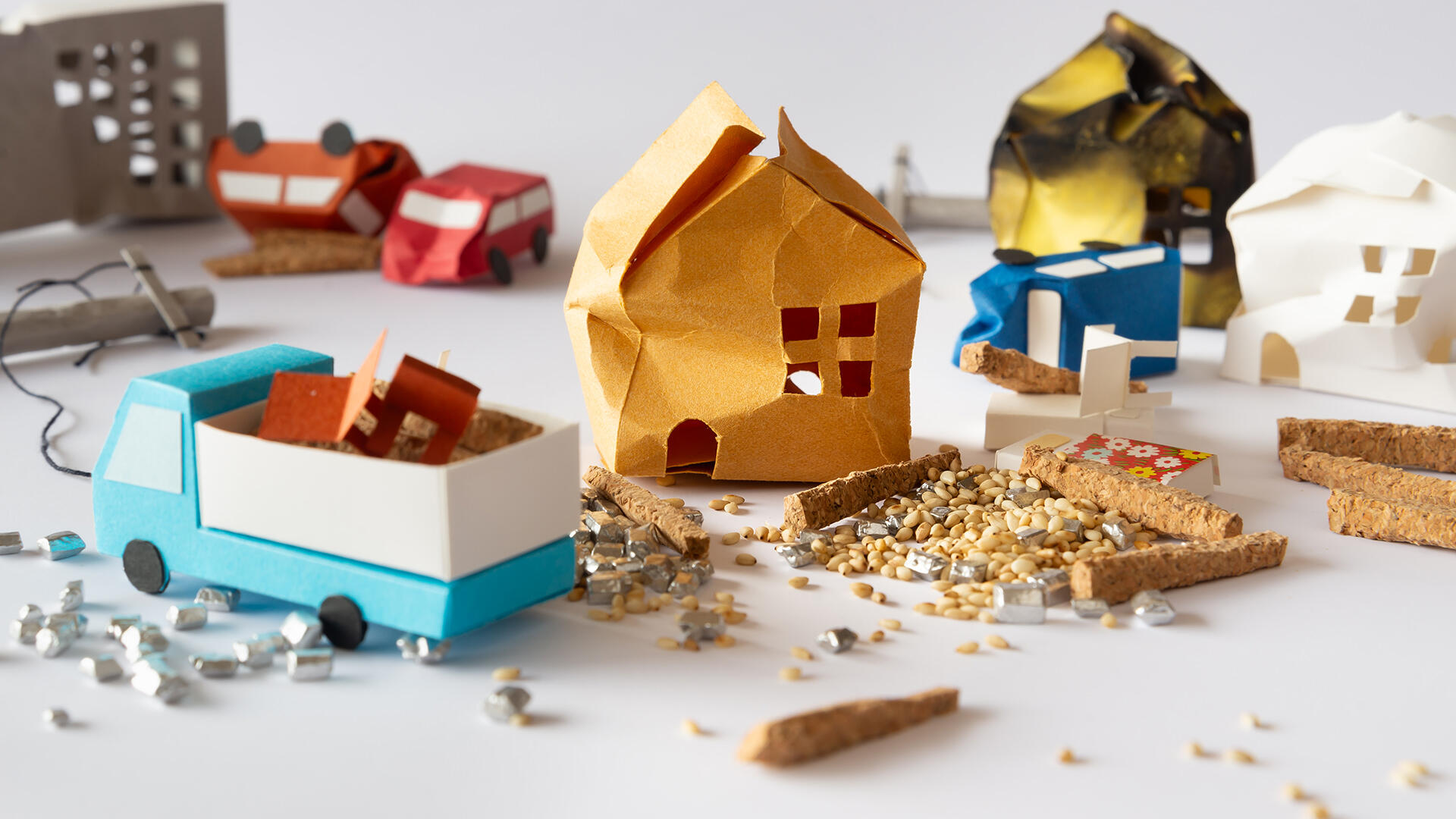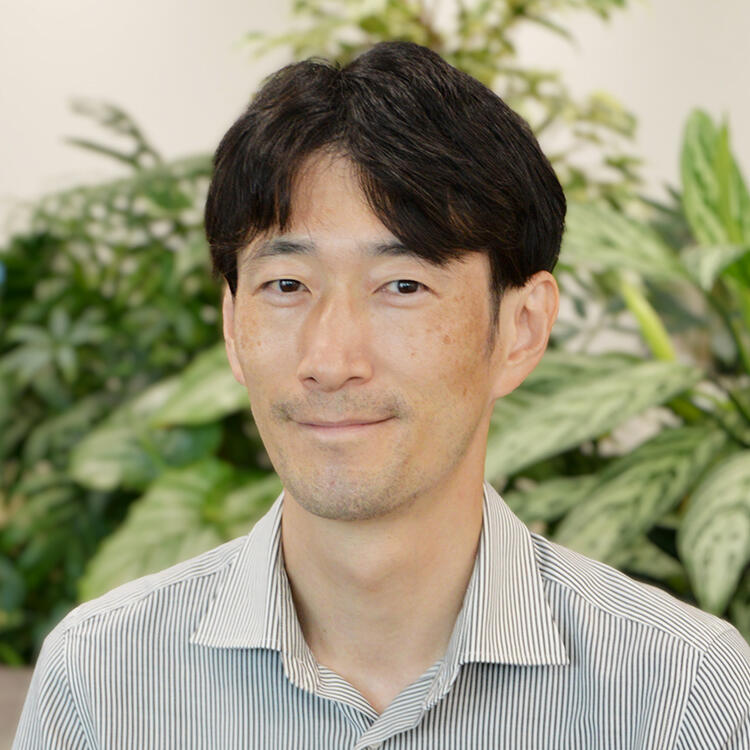Following the Great East Japan Earthquake, the formulation of a "Disaster Waste Disposal Plan" became mandatory. It is said that approximately 80% of municipalities and 100% of prefectures have already formulated such plans, but to make the plans more effective, it is essential to review them regularly. We spoke to Junya UEDA, chief consultant of the Regional Environment Development Sec., Resource Circulation Management Dept., and Kosuke NOZUE, an engineer in the same Section, about the key points of the update.
INDEX
- Disaster Waste Disposal is an Important Issue When a Disaster Occurs
- Unexpected Occurrences Call for Review of Disposal Plan
- Issues in Disaster Waste Disposal Revealed by the 2024 Noto Peninsula Earthquake
- Key Points for Updating Disaster Waste Disposal Plan
- PACIFIC CONSULTANTS' Initiatives
Disaster Waste Disposal is an Important Issue When a Disaster Occurs
In the event of a large-scale disaster, such as the predicted Nankai Trough Megathrust Earthquake or a Tokyo Metropolitan Earthquake, a large amount of disaster waste is expected to be generated, and planning for its appropriate disposal is considered essential for rapid recovery and reconstruction.
In the wake of the Great East Japan Earthquake, the national government revised the law on disaster waste disposal, and municipalities and the prefectures that govern them, are now required to formulate disaster waste disposal plans tailored to the characteristics of their respective regions. With the support of the Ministry of the Environment, approximately 80% of municipalities and 100% of prefectures have completed their formulation. Needless to say, if the large amount of disaster waste that is generated all at once is not disposed of properly, smoothly and quickly, it will not only be a major hindrance to recovery and reconstruction, but it may also lead to a deterioration of the sanitary environment and, in the worst case, the spread of infectious diseases. There are also concerns that the lack of progress in cleaning up damaged houses will worsen the living environment and lead to disaster-related deaths. It goes without saying that saving lives immediately after a disaster occurs is the first priority, but the proper disposal of disaster waste is also an extremely important issue that must be addressed when a disaster occurs.
Unexpected Occurrences Call for Review of Disposal Plan
However, it is difficult to predict when and where a disaster will occur, and it is impossible to prepare a perfect disaster waste disposal plan in advance. Identifying the issues related to waste disposal that arise every time a disaster occurs and updating the disposal plan each time leads to a more effective disaster waste disposal plan.

For example, some local governments voluntarily formulated disaster waste disposal plan following the Great Hanshin-Awaji Earthquake in 1995. At the time, no assumptions had been made about tsunami damage, so most of the disaster waste covered by the plans was from earthquakes. However, the Great East Japan Earthquake caused widespread tsunami damage, resulting in the unexpected creation of "massive amounts of disaster waste submerged in seawater."
If the salt concentration in waste is high, it can cause dioxin generation, corrosion of incineration facilities, and restrictions on the use of wood chips. We have newly discovered the need to consider how to remove salt from waste. If this is not included in the plan, it will be virtually impossible to treat the waste.
In addition, in recent years, flood damage caused by typhoons and torrential rains has been increasing, and when embankments collapse, mud that has accumulated in the riverbed flows out with the waste, resulting in muddy waste and waste mixed with soil and sand. If the waste contains soil and sand, the amount of incineration residue will increase and it will not be possible to recycle the waste, so it is essential to separate the soil and sand and remove the mud, and it is desirable to consider where and how this will be done in the disposal plan.

In addition, in the case of flood damage, temporary storage sites must be opened quickly. In the case of earthquake damage, there is a need to be on guard against aftershocks for a while, and many people will spend a few days to a week in evacuation centers. Therefore, there is some time to set up temporary storage sites. However, in the case of flood damage, the water may have subsided by the next day, so waste disposal can begin immediately. If temporary storage sites have not been set up, garbage cannot be removed and disposal cannot begin.
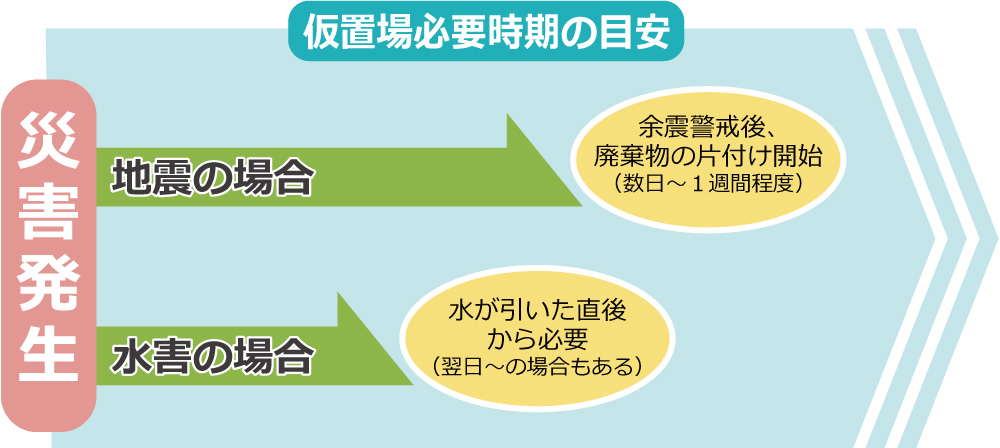
Issues in Disaster Waste Disposal Revealed by the 2024 Noto Peninsula Earthquake
The 2024 Noto Peninsula Earthquake, which occurred on January 1, 2024, also had many "unforeseen" events regarding disaster waste.
Stagnation of Disposal of Household Waste, Evacuation Center Waste, and Human Waste
This is about dealing with ordinary household waste, waste from evacuation shelters, and human waste, which were only mentioned in supplementary terms in previous disaster waste disposal plans. In the 2024 Noto Peninsula Earthquake, roads were cut off everywhere and water and sewerage facilities were also severely damaged, so many private evacuation shelters were set up in addition to public evacuation shelters, and people stayed there for a long time. Furthermore, many waste disposal facilities were damaged and stopped operating, which caused major problems in the disposal of household waste, evacuation shelter waste, and human waste.
Massive Demolition at Public Expense, including Vacant Houses with Unknown Owners
The problem of vacant houses was also an issue in the 2016 Kumamoto Earthquake and the 2018 Heavy Rains (Western Japan Heavy Rain Disaster, 2018), but it was brought into the spotlight again as a serious problem that hinders major recovery efforts in the 2024 Noto Peninsula Earthquake. There were reports that the demolition of buildings that were completely or partially destroyed was not progressing and that "six months have passed and the buildings remain in the same condition as they were at the time of the disaster." The background to this was that the huge number of buildings targeted for demolition at public expense took time to review, and it was difficult to secure the heavy machinery, materials, and personnel needed for demolition and their accommodation, as well as the problem that the owners could not be identified because the houses were vacant. Even if a house is completely or partially destroyed, local governments cannot dispose of it on their own, and if there is such a vacant house in front of a house to be demolished, the house behind it cannot be demolished either.
Obstacles to Accepting Disaster Volunteers
Another issue that emerged in the waste disposal process following the 2024 Noto Peninsula Earthquake was the delay in coordinating with disaster volunteers. Disaster volunteers are essential for cleaning up damaged houses. Especially in rural areas, many elderly people live alone, and without the support of many people, cleaning up cannot be started. However, due to the extremely poor transportation situation and the inability to secure water, food, and accommodation, a policy was adopted at the beginning of the disaster to ask disaster volunteers from outside the area to refrain from coming, which resulted in the cleaning up of damaged houses not progressing.
Key Points for Updating Disaster Waste Disposal Plan
When a disaster occurs, it is impossible to predict when you will become a victim. That is why, when a disaster occurs in another municipality, it is important to check whether your own organization's plan is sufficient to respond, and for municipalities that have not yet formulated a plan, it is important to understand the necessity and share the importance within the municipality so that they can work on formulating a plan. Since municipalities that lack manpower are likely to be unable to work on formulating a plan through internal coordination alone, it is also important to encourage the head of the municipality to demonstrate leadership and to consult with the Ministry of the Environment's Regional Environmental Office.
Specifically, the key points of the update are as follows:
Who Updated It and When? Does the Relevant Eepartment Understand the Content?
First of all, it is necessary to check whether updates have been made. In local governments, staff members are transferred regularly, and handover of the "disaster waste disposal plan" tends to be put off because the handover between the old and new staff members takes priority over daily work. In one local government, even though a disposal plan had been created, the staff in the relevant department were unaware of its existence.
Disaster waste disposal is a task that spans multiple departments within the city government. In most cases, the disposal plan describes the coordination with each department (Disaster Prevention Division, Environment Division, Civil Engineering Division, Maintenance Division, etc.), but even if the plan includes the names of each department, there are cases where they are not actually known to each department. It is necessary to check in peacetime whether each department understands what they need to do.
Is the Disaster Waste Disposal Plan Effective? Has Feedback Been Provided on Lessons Learned from Actual Disaster Waste Disposal?
- Expected Types and Amounts of Disaster Waste
The type of waste that needs to be disposed of and the method of disposal vary depending on the type of disaster. Most conventional plans are based on the assumption of an earthquake, but plans for damage caused by tsunamis and river flooding that are tailored to the characteristics of the region are needed. - Securing a Sufficient Amount of Space for Temporary Storage Sites and Establishing a System for Managing and Operating Them
The establishment of a temporary storage site is one of the most important parts of a disaster waste disposal plan. It is important to clarify whether the planned site has sufficient area (especially whether there is enough space for on-site sorting and separation), who will manage and operate the site, and under what system.
At disaster sites, various needs arise regarding land use, such as construction sites for temporary housing, storage sites for heavy machinery and materials for recovery, temporary heliports, and accommodation sites for disaster relief units. Furthermore, there is a possibility that disaster waste storage sites may cause soil contamination, and private land is difficult to use. Since departments related to disaster recovery may end up competing for limited land, a coordination function is necessary. - Measures for the Treatment of Household Waste, Evacuation Shelter Waste, and Human Waste
Conventional disaster waste disposal plans do not include detailed consideration of how to dispose of this type of waste, and the topic is placed at the end of the plan's chapters. However, if this section fails, it will be difficult to return to daily life. It is necessary to consider how to continue normal waste disposal, including the need for wide-area support. - Clarifying Cooperation with Disaster Volunteers, Chain of Command, and Instructions
Disaster volunteers are essential for cleaning up houses. However, disaster waste disposal plans often lack sufficient rules on who should tell disaster volunteers what and how they should act. - Clarification of How to Request Support
Most prefectures have agreements in place to support disasters with private construction and civil engineering business associations, industrial waste business associations, heavy equipment manufacturers, rental business associations, and individual business companies. However, there are cases where local government officials are unaware of their existence, or, even if they are aware of them, assume they cannot use them because they are not directly affiliated with them. Agreements with prefectures can be used if a local government requests them, so disaster waste disposal plans must clearly state the contents of the support agreements that prefectures have concluded, as well as valid contact information and phone numbers for requests.
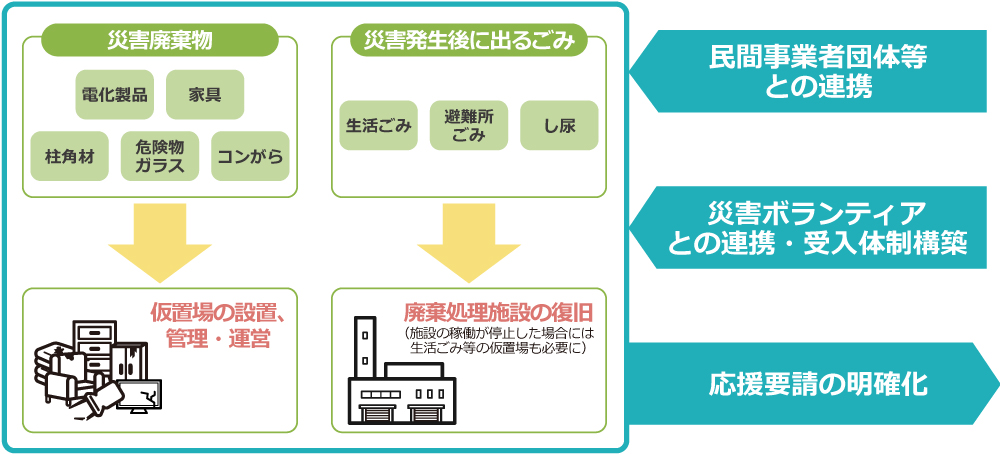
PACIFIC CONSULTANTS' Initiatives
PACIFIC CONSULTANTS has been involved in many projects to support the formulation of disaster waste disposal plans at the Ministry of the Environment's regional environmental offices and local governments. Each of our engineers also provides support at disaster sites as D.Waste-Net *1), so they have knowledge of the problems that arise at actual disaster waste disposal sites, and by feeding this knowledge back into the disposal plans, we support the creation of highly effective plans that are tailored to the actual conditions of each region.
In addition, as part of the work of the Ministry of the Environment, we have been involved in formulating and revising the "Guidelines for Disaster Waste Management" and the "Guidelines for Action for Disaster Waste Management in the Event of a Large-Scale Disaster," so we are able to support the formulation of the required disposal plan in accordance with its essential purpose.
When it comes to specific support for planning, in addition to the usual support work of consultants creating plans and working with local governments to create them, we also provide interactive support for planning, where we first have local government officials consider the specific circumstances of the local government based on a plan-making text that condenses our experience with disaster waste disposal, and then we review the plan and provide feedback to the local government to help refine it. This is because we believe that rather than taking on the entire task of planning, we simply have local government officials formulate the plan and then support them in this process, which will lead to improved disaster response capabilities for local governments.
In addition to formulating disaster waste disposal plans, Mie Prefecture is also working on improving disaster response capabilities. Mie Prefecture is conducting tabletop exercises on disaster waste disposal and on-site training on the installation and operation of temporary storage sites, which are essential for disaster waste disposal. Participating local governments have praised these exercises, saying they are "very helpful as they highlight issues."
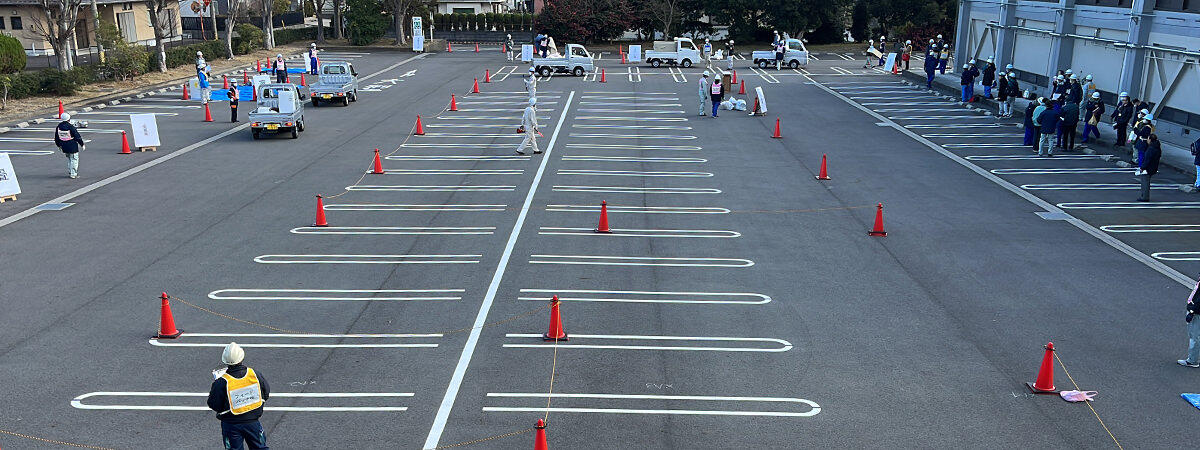

Recently, we have also been involved in experimental study of PLATEAU *2) being carried out by Ministry of Land, Infrastructure, Transport and Tourism. We are actively involved in the development of digital tools to promote the sophistication of disaster waste disposal plans, such as simulating the amount of disaster waste generated and using the calculation results to consider the accumulation range for each temporary storage site, as well as considering countermeasures for areas with a shortage of land.
The formulation of disaster waste disposal plans requires knowledge about the establishment, management and operation of temporary storage sites, collection of disaster waste, intermediate processing, recycling and final disposal, as well as specialized knowledge about the various departments involved in disposal (disaster prevention, civil engineering and construction, roads, ports, environment, etc.), and consultants are required to have comprehensive capabilities. By utilizing the expertise and comprehensive capabilities of PACIFIC CONSULTANTS, we hope to contribute to the realization of a society where everyone can live in peace and security by supporting the formulation of detailed disaster waste disposal plans.
*1 D.Waste-Net: Abbreviation for the Disaster Waste Disposal Support Network operated by the Ministry of the Environment. Based on requests for cooperation from the Ministry of the Environment, members of research and specialist institutions with specialized knowledge of disaster waste disposal provide various support in each phase of "disaster occurrence" and "peacetime" to ensure that disaster waste is disposed of appropriately, smoothly, and quickly according to the type and scale of the disaster.
*2 Project PLATEAU: A project led by Ministry of Land, Infrastructure, Transport and Tourism to develop 3D city models and make them open data. As experimental study in the field of disaster prevention, the project simulated the amount of disaster waste generated within a specified range by overlaying various data on damage factors such as expected seismic intensity on the attributes of each building (year of construction, building structure, number of floors, total floor area, etc.), and promoted the study of the accumulation range for each temporary storage site and countermeasures for areas with a shortage of land, thereby playing a role in improving disaster waste disposal plans.



